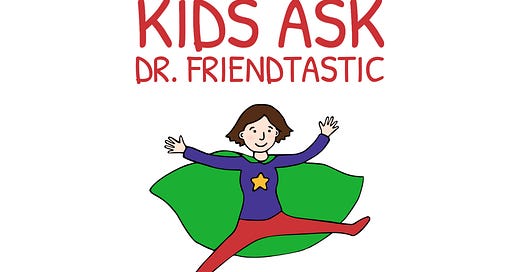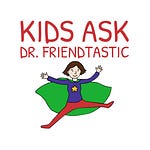(Would you rather read? A TRANSCRIPT is at the bottom of this post.)
Richard wants to know how to show more empathy for other kids..
Scroll down for some DISCUSSION QUESTIONS you can share with your child, plus how to submit your child’s question.
*** Please tell me about you! ***
I want to make sure that the Dr. Friendtastic newsletter is something you look forward to seeing in your email inbox.
If you haven’t already, would you please answer some quick questions to help me provide you with the most useful information?
Thank you!!! I appreciate your time and support!
Would YOUR kid enjoy being featured on the podcast?
Adults, please use your smartphone's memo function or an audio app to record your child's question. Hold the phone close to your child's mouth to make sure the recording is clear. Have your child state:
1) their FIRST NAME (or another first name),
2) their AGE, and
3) a BRIEF QUESTION or concern about friendship. (Please do not include any friends' names.)
Email the audio file to DrF@EileenKennedyMoore.com. I’ll answer as many questions as I can. (Obviously, this is not psychotherapy, and it’s not for emergency situations.)
Think About It Questions to discuss with your child
Which do you think is the hardest part of showing empathy: Paying attention, imagining the other person’s perspective, caring, or caring action? Why?
Why do you think friends who are feeling upset often don’t want advice? What do you think they might want instead? What does Dr. Friendtastic mean when she says, “Unwanted advice can come across as criticism”?
How might showing empathy look different with a close friend versus someone you don’t know well?
Why is it a good idea to say “you” rather than “I” when you’re empathizing with a friend? (Hint: Where do you want the focus to be?) How might feeling very emotional yourself get in the way of offering empathy for a friend?
Why is it important to ask, “What can I do to help?”
Dr. Friendtastic mentions a bunch of examples of small acts of kindness to show you care about someone. What are some small acts of kindness you’ve done to show your friends you care?
Transcript
Welcome! I’m Dr. Eileen Kennedy-Moore, also known as Dr. Friendtastic. I’m an author and clinical psychologist based in Princeton, NJ.
Here’s today’s question:
Hello, my name is Richard. I'm 11 years old, and my question is, how to show more empathy for your classmates?
Hi, Richard! Thank you for sending in this question! I like that you’re asking, not just how to have empathy for other kids, but how to show it.
Empathy means feeling for and with someone. So, for example, if a friend feels sad about their goldfish dying, empathy would allow you to also feel sad, along with the friend, which could help you respond in a caring way.
The first ingredient of empathy is attention. You need to notice when your friends are feeling emotional. Sometimes, kids will tell you directly, “I’m feeling frustrated!” But sometimes you have to look at their nonverbal communication–how they’re showing emotions in their face, body, or tone of voice.
For instance, if you’re playing a game, and your friend suddenly stops talking and just stands there with their arms crossed, looking away, with their lips tightly together and their eyebrows down–whoa! Those are a whole bunch of clues that the friend is having some big feelings!
The second ingredient of empathy is perspective-taking: imagine how the friend might be feeling and why. It takes practice to get good at this. Use what you know about your friend, plus your own experience, and think about how the friend might be reacting to whatever’s happening. It helps if you know lots of words to describe emotions, so you can understand them and tell them apart.
Using the example of the friend who stopped playing, maybe that friend is feeling frustrated or discouraged or jealous or angry or hurt… Thinking about what’s happening, how your friend has reacted in the past, and how you would react in that situation can help you guess how your friend might be feeling.
The third ingredient is caring. You might notice and understand someone’s feelings, but unless you care, you can’t empathize. When you have empathy for a friend, if the friend is disappointed, you also feel disappointed for and with them; if they feel excited, you also feel excited for and with them.
Here’s something a lot of people don’t realize about empathy: You have to be able to manage your own feelings in order to empathize with others. If you’re overwhelmed by how you’re feeling, that will take up all your focus, and there won’t be any space in your brain available to empathize with someone else’s feelings, until you manage to settle down.
Noticing, understanding, and caring (but not getting overwhelmed) about how someone else is feeling all help you have empathy. If we want that empathy to show, we need to add one more ingredient, which is caring action.
What kind of caring action you take depends on the situation and your relationship. Someone you don’t know well doesn’t necessarily want anything from you, but a close friend will expect you to care.
Often kids think that if a friend is upset, they have to fix the friend’s problem or give advice, but that’s usually not what a friend is looking for. Unwanted advice can come across as criticism–like you’re saying, “I know better than you!”
Instead, you might try listening and maybe echoing your friend’s words and feelings. It feels good to be heard and understood. You could say, “It sounds like you’re mad about that,” or “You’re so happy about that!” or “You’re worried because…” Keep the focus on your friend who is feeling emotional by saying the word “you” rather than “I.”
You may want to ask your friend what kind of support they want. You could say, “What can I do to help?” or “What would you like us to do now?”
Sometimes, doing a small act of kindness can express caring. Inviting a friend to do something with you, letting them go first, playing the game they like, sharing something with them, or giving them a supportive note or a small drawing or craft you made are all ways to say, “I care about you.”
This has been Kids Ask Dr. Friendtastic. If you have a question about making and keeping friends that you’d like me to answer, go to DrFriendtastic.com, and click on the podcast tab to see how to submit your question.
And be sure to check out my funny and practical books for kids about friendship: Growing Friendships: A Kids’ Guide to Making and Keeping Friends, and my new book, Growing Feelings: A Kids’ Guide to Dealing with Emotions About Friends and Other Kids. They’re available through your library or wherever you buy books.












Share this post